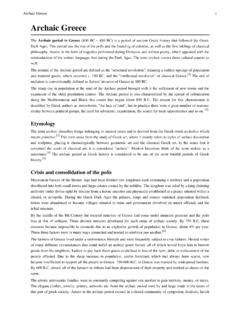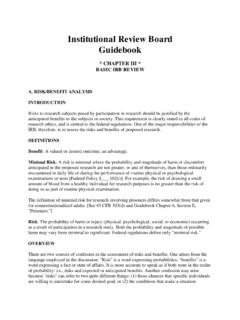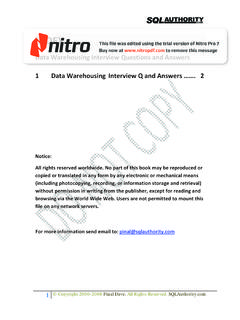Transcription of Chapter 10 Gathering and Using Information: …
1 Chapter 10. Gathering and Using information : marketing Research and Market Intelligence Once you have come up with a great idea for an offering, how will you know if people will want to buy it? If they are willing to buy it, what will they want to pay? Will they be willing to pay enough so that you can earn a profit from the product? Wouldn't it be great if you had some sort of crystal ball that would give you the answers to these questions? After all, you don't want to quit your day job to develop a product that's going to be a flop. In a sense, you do have such a crystal ball. It's called marketing research. marketing research is the process of collecting, analyzing, and reporting marketing information that can be used to answer questions or solve problems so as to improve a company's bottom line.
2 marketing research includes a wide range of activities. (By contrast, market research is a narrower activity. It is the process of researching a specific market to determine its size and trends.). Although marketing research isn't foolproof, it can take some of the guesswork out of decision making. Back to your great product idea: what, for example, should you name your product? Naming a product might sound like a minor decision, but it's not. In some cases it can be a deal breaker. Just ask the bug-spray maker Out! International, Inc. In the 1990s, Out! International came up with what it thought was a really cute name for bug spray that would appeal to children.
3 The product was called Hey! There's a Monster in My Room! The problem was that the name [1]. itself scared kids. They wanted nothing to do with it. Saylor URL: 1. Figure A little marketing research might have helped: In 1966, Capitol Records released hundreds of thousands of the Beatles' album Yesterday and Today with the cover shown here. Do you think it was well received? No. The public was appalled. Capitol Records quickly realized it had made a mistake, recalled the albums, and pasted a different cover over what became known as the butcher cover. (Note: Some of the albums slipped through the cracks and didn't get the paste-over. If you can find one, it could be worth thousands of dollars.)
4 Source: Wikipedia. marketing research can help you with many tasks: Developing product ideas and designs Determining if there is demand for your product so you know whether or not to produce it Identifying market segments for your product Making pricing decisions Evaluating packaging types Saylor URL: 2. Evaluating in-store promotions Measuring the satisfaction of your customers Measuring the satisfaction of your channel partners Evaluating the effectiveness of your Web site Testing the effectiveness of ads and their placement Making marketing channel decisions Closely related to marketing research is market intelligence, which is often referred to as competitive intelligence.
5 Whereas marketing research involves solving a specific marketing problem at a specific point in time, market intelligence involves Gathering information on a regular, ongoing basis to stay in touch with what's happening in the marketplace. For example, if you own a convenience store, part of your daily market intelligence Gathering would include driving around to see what competing stores are charging for gasoline or checking to see what types of products are being sold and advertised by them. If you're a small business owner, and you're talking to your customers and suppliers about new product ideas, you're engaging in market intelligence. If you go so far as to survey your customers with a questionnaire about a new type of service you're considering offering, you are engaging in marketing research.
6 In big companies, marketing departments are often responsible for Gathering market intelligence. But they are by no means the only group to do so. (We'll discuss more about who in the organization does which activities in a moment.) Students also gather market intelligence when they question other students about the best professors to take classes from. [1] Seth Stern, The Museum of Food Failures, Christian Science Monitor, July 2, 2002, (accessed December 14, 2009). Saylor URL: 3. marketing information Systems LEARNING OBJECTIVES. 1. Describe the components of a marketing information system and each component's purpose. 2. Explain the situations in which marketing research should be used versus market intelligence.
7 3. Describe the limitations of market intelligence and its ethical boundaries. 4. Explain when marketing research should and should not be used. A certain amount of marketing information is being gathered all the time by companies as they engage in their daily operations. When a sale is made and recorded, this is marketing information that's being gathered. When a sales representative records the shipping preferences of a customer in a firm's customer relationship management (CRM) system, this is also marketing information that's being collected. When a firm gets a customer complaint and records it, this too is information that should be put to use. All this data can be used to generate consumer insight.
8 However, truly understanding customers involves not just collecting quantitative data (numbers) related to them but qualitative data, such as comments about what they think. Audio Clip Interview with Joy Mead Recall from Chapter 3 "Consumer Behavior: How People Make Buying Decisions" that Joy Mead is an associate director of marketing with Procter & Gamble. Listen to this clip to hear Saylor URL: 4. Mead talk about the research techniques and methods Procter & Gamble uses to develop consumer insight. You will learn that the company isn't just interested in what consumers want now but also years in the future. The trick is integrating all the information you collect so it can be used by as many people as possible in your organization to make good decisions.
9 Unfortunately, in many organizations, information isn't shared very well among departments. Even within departments, it can be a problem. For example, one group in a marketing department might research a problem related to a brand, uncover certain findings that would be useful to other brand managers, but never communicate them. A marketing information system (MIS) is a way to manage the vast amount of information firms have on hand information marketing professionals and managers need to make good decisions. marketing information systems range from paper-based systems to very sophisticated computer systems. Ideally, however, a marketing information system should include the following components: A system for recording internally generated data and reports A system for collecting market intelligence on an ongoing basis marketing analytics software to help managers with their decision making A system for recording marketing research information Internally Generated Data and Reports As we explained, an organization generates and records a lot of information as part of its daily business operations, including sales and accounting data, and data on inventory levels, back orders, customer returns, and complaints.
10 Firms are also constantly Gathering information related to their Web sites, such as clickstream data. Clickstream data is data generated about the number of people who visit a Web site and its various pages, how long they dwell there, and Saylor URL: 5. what they buy or don't buy. Companies use clickstream data in all kinds of ways. They use it to monitor the overall traffic of visitors that a site gets, to see which areas of the site people aren't visiting and explore why, and to automatically offer visitors products and promotions by virtue of their browsing patterns. Software can be used to automatically tally the vast amounts of clickstream data gathered from Web sites and generate reports for managers based on that information .












